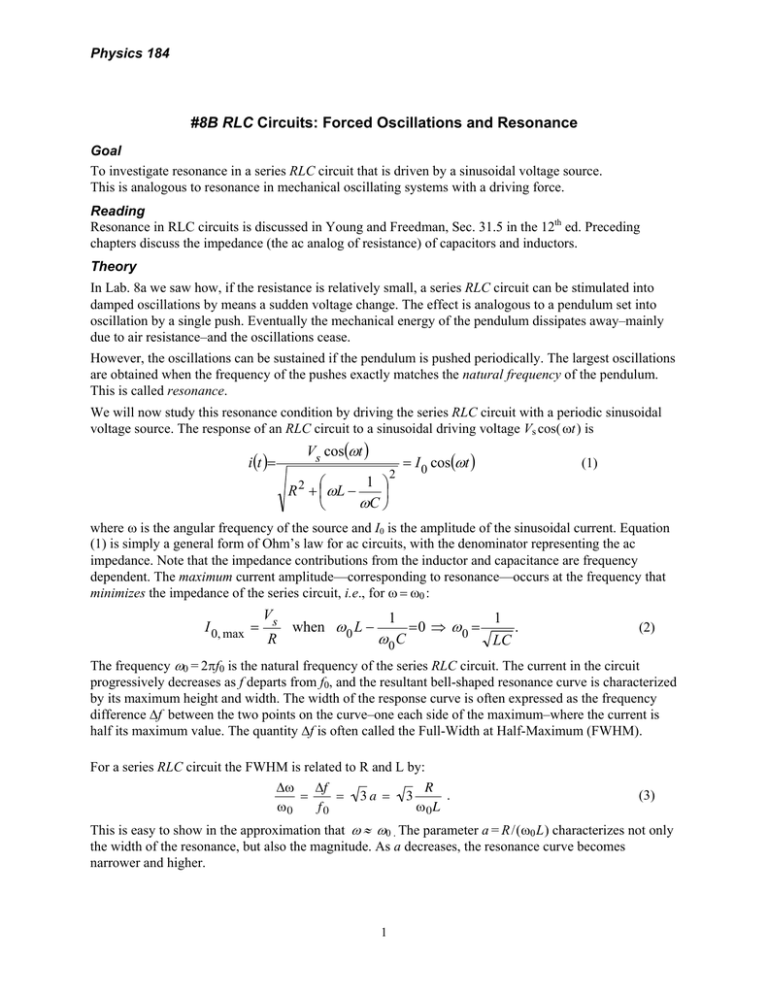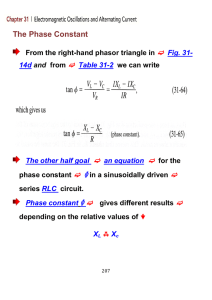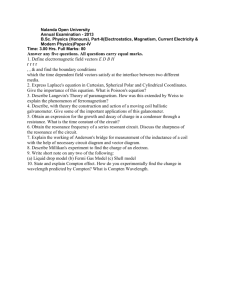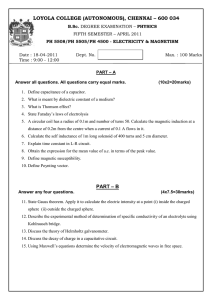( ) ( ) ( )t
advertisement

Physics 184 #8B RLC Circuits: Forced Oscillations and Resonance Goal To investigate resonance in a series RLC circuit that is driven by a sinusoidal voltage source. This is analogous to resonance in mechanical oscillating systems with a driving force. Reading Resonance in RLC circuits is discussed in Young and Freedman, Sec. 31.5 in the 12th ed. Preceding chapters discuss the impedance (the ac analog of resistance) of capacitors and inductors. Theory In Lab. 8a we saw how, if the resistance is relatively small, a series RLC circuit can be stimulated into damped oscillations by means a sudden voltage change. The effect is analogous to a pendulum set into oscillation by a single push. Eventually the mechanical energy of the pendulum dissipates away–mainly due to air resistance–and the oscillations cease. However, the oscillations can be sustained if the pendulum is pushed periodically. The largest oscillations are obtained when the frequency of the pushes exactly matches the natural frequency of the pendulum. This is called resonance. We will now study this resonance condition by driving the series RLC circuit with a periodic sinusoidal voltage source. The response of an RLC circuit to a sinusoidal driving voltage Vs cos( ωt) is i (t )= Vs cos(ωt ) 1 ⎞ ⎛ R 2 + ⎜ ωL − ⎟ ωC ⎠ ⎝ 2 = I 0 cos(ωt ) (1) where ω is the angular frequency of the source and I0 is the amplitude of the sinusoidal current. Equation (1) is simply a general form of Ohm’s law for ac circuits, with the denominator representing the ac impedance. Note that the impedance contributions from the inductor and capacitance are frequency dependent. The maximum current amplitude—corresponding to resonance—occurs at the frequency that minimizes the impedance of the series circuit, i.e., for ω = ω0 : V 1 1 I 0, max = s when ω 0 L − = 0 ⇒ ω0 = . R ω0C LC (2) The frequency ω0 = 2πf0 is the natural frequency of the series RLC circuit. The current in the circuit progressively decreases as f departs from f0, and the resultant bell-shaped resonance curve is characterized by its maximum height and width. The width of the response curve is often expressed as the frequency difference Δf between the two points on the curve–one each side of the maximum–where the current is half its maximum value. The quantity Δf is often called the Full-Width at Half-Maximum (FWHM). For a series RLC circuit the FWHM is related to R and L by: Δω Δf R . = = 3a = 3 ω0 f0 ω0L (3) This is easy to show in the approximation that ω ≈ ω0 . The parameter a = R/(ω0 L) characterizes not only the width of the resonance, but also the magnitude. As a decreases, the resonance curve becomes narrower and higher. 1 Physics 184 Scope Measurements - REVISED C The circuit for this experiment is almost the same as employed for Lab 8a. The difference is that rather than switching the RLC combination on and off using a low-frequency square wave, the circuit is to be powered by a sinusoidal wave of variable frequency f of the order of 1 kHz. L First connect the four circuit elements: R0 L, C, and the function generator in series, as shown. Any wire connected to the function generator ground (black terminal) should be black. Any wire connected to the function generator output signal (red terminal) should be red. Scope Now connect the ground to the channel 1 oscilloscope ground (black terminal) with a black wire. Connect the function generator output signal to the scope channel 1 input (red terminal) with a red wire. Connect the non-ground side of R0 to the scope channel 2 input with a red wire. As in past experiments, use the Measure menu to set the digital oscilloscope to report the channel 1 frequency and the peak-to-peak voltages on channels 1 & 2. Ratios of peak-to-peak voltages are equal to the ratios of the amplitudes. R0 Scope ground Fig. 4. Circuit for studying forced oscillations. The measurements will determine the amplitude I0 of the current i(t) as a function of frequency and the resistance R0. The current amplitude I0 is determined by measuring the voltage across R0. As indicated by Eq. (1), the impedance of the circuit —and hence the voltage amplitude delivered by the function generator— changes with frequency f. This makes it difficult and time-consuming to keep VS constant, and we will not attempt to do that. However, the ratio of the current amplitude to the source voltage amplitude has the same functional form as the current amplitude for constant VS. The analysis of resonance in R-L-C circuits will be done by studying how the ratio I 0 VS = VR R0 VS varies with frequency, and with the value of R0.. 1. Record the inductance L, inductance resistance RL, and capacitance C. Calculate the expected resonant frequency f0, and the total circuit resistance R that would result in critical damping. (See expt. 8a.) 2. These measurements are aimed at studying the maximum current and FWHM of the resonance shape for various values of R0. Start with a value of R0 that ensures that the circuit is underdamped. A value of 50 Ω or 100 Ω is suggested. 3. With the output of the function generator on oscilloscope channel 1, and the voltage across resistor R0 on channel 2, find the resonant frequency by tuning the frequency to obtain maximum VR. You will notice that these two signals are in phase only at the resonant frequency. This observation of the phase is the most sensitive way to determine the resonant frequency. 4. Change the frequency so that the peak-to-peak VR is about 80% of the maximum value. Record the frequency and the peak-to-peak values of VR and VS. 5. Repeat this for frequencies at which peak-to-peak VR values are about 60%, 40%, and 20% of the maximum value. This requires a set of frequencies above resonance, and another set below. 6. Double the value of R0, and repeat steps 3 through 5. Double R0 again, and repeat steps 3 through 5. 7. Data tables and suggestions for analysis of the data in terms of Equation 3 are on the report sheet. 2 Physics 184 #8B Laboratory Report Sheet RLC Circuits: Forced Oscillations and Resonance Name: _______________________________ Partner: _____________________________ Lab Section: __________________________ Date: _____________________________ 1. Parameter values: RL = _____________ Ω L =_____________ H Predicted f = 0 1 2π C =_____________ μF 1 = ______________ kHz LC 2. Experimental resonant frequency and resonance width: Take data as indicated in the instructions, and plot three resonances curves on a single graph with a frequency axis extending from about 500 Hz to 2500 Hz. Partners can share measurement, calculating, and graphing duties. Measure the FWHM from the graphs. R0 = _____________ Ω Freq. (kHz) VR0 VS R0 = _____________ Ω V R R0 Freq. VS (kHz) f0 VR0 VS V R R0 VS f0 FWHM = fHI – fLO = ___________Hz FWHM = fHI – fLO = ___________Hz Δω = 2 π (fHI – fLO) = ___________s-1 Δω = 2 π (fHI – fLO) = ___________s-1 1 Physics 184 R0 = _____________ Ω Freq. VR0 (kHz) VS R0 = _____________ Ω V R R0 Freq. VS (kHz) F0 VR0 VS V R R0 VS f0 FWHM = fHI – fLO = ___________Hz FWHM = fHI – fLO = ___________Hz Δω = 2 π (fHI – fLO) = ___________s-1 Δω = 2 π (fHI – fLO) = ___________s-1 3. Final Data Analysis • Plot a graph of Δω as a function of R0. The R axis should include about 100 Ω to the left of zero (negative R). Draw the best straight line through the data. How much additional resistance would have to be added to each data point to make the line pass through the origin? Compare this with RL. • Calculate the slope of the straight line, and calculate L from the slope. R According to Equation 3, Δω = 3 . Comment on your result. L • Calculate the product of the maximum current and Δω for each of the 3 sets of data. Compare these three products. 2



